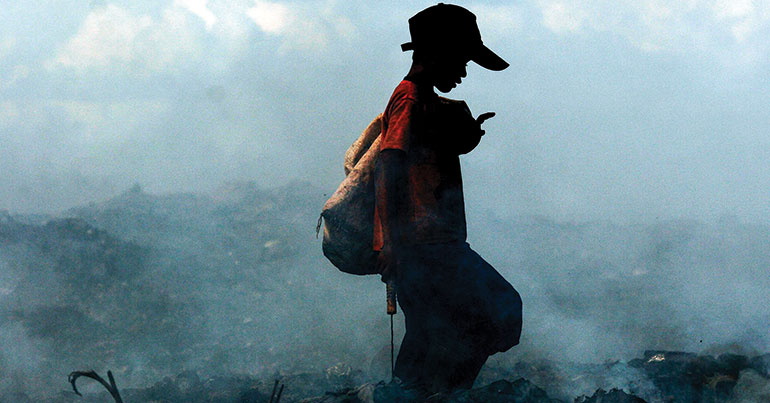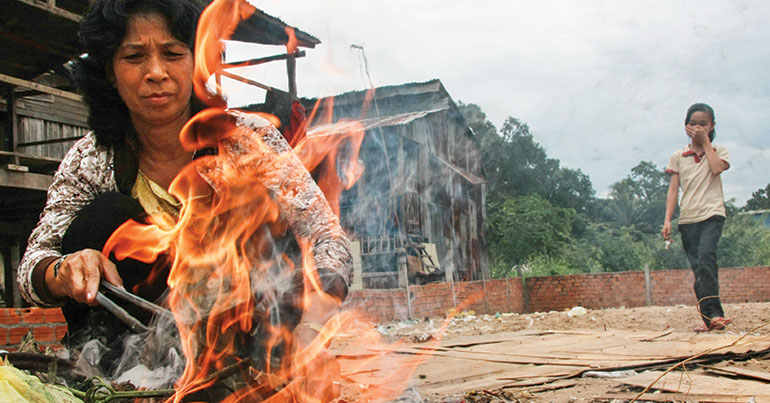Thiv Sophearith stands on top of the Ministry of Environment building with the sun beaming down on him. The sky is clear, aside from a thin veil of smog hovering low against the skyline.
“You can see a lot of construction sites, so [these developments] can cause the PM2.5 to be a little bit high here,” he says, pointing to a cluster of scaffolding-wrapped developments where sparks fly from saws and drills.
As chief of the ministry’s Air Quality, Noise and Vibration Office, Sophearith has spent just over a year monitoring Phnom Penh’s levels of PM2.5, the most damaging air pollutant to human health, which exists as tiny particles created from dust and burning fossil fuels. These particles can contribute to heart disease, strokes and lung illnesses such as cancer and emphysema.
The device that collects the data arrived in April last year and lives beside two acidic deposition pollution monitors on the roof of the ministry building, from which the Tonle Sap river is not much more than a coin toss away. Before this machine, there was no officially recognised monitor of the capital city’s PM2.5 air pollution, leaving the issue a mystery to all.
“Thirty-one,” says Sophearith, peering into a metal cupboard in the centre of the rooftop to read the device’s monitor. This is the most recent hourly measurement of the number of micrograms of PM2.5 particles per cubic metre of air – above the World Health Organisation’s (WHO) recommended level of 25. A pole shooting up from the cabinet absorbs the particles and quickly calculates the average amount every hour, which is then added up to find a monthly average for government records.
In March, the average rate was 29, Sophearith says – well above any of the average rates of the nine months measured last year, which jumped around between levels as low as 9.9 and as high as 19.8. “This level is not a high level,” he insists of the 31 reading.
Phnom Penh has seen worse. Data from another Phnom Penh PM2.5 monitor, at the Olympic Stadium about a ten-minute drive away, tracked by global air pollution monitoring platform AirVisual, shows a morning in early April when the level skyrocketed to 111.
Data from 2017 places Phnom Penh’s average annual air quality as much better than Hanoi and Beijing’s
AirVisual
Generally speaking, these monitors should be picking up similar if not the same rates of PM2.5, according to Yann Boquillod, a Beijing-based data scientist and founder of AirVisual.
Comparatively, the nation’s annual records aren’t bad. AirVisual data from 2017 places Phnom Penh’s average annual air quality as much better than Hanoi and Beijing’s – with a PM2.5 level of 27.4 in Cambodia’s capital compared to 42.6 in the Vietnamese capital and 52.7 in China’s. Still, in the more developed urban centre of Paris, PM2.5 hovered just over 15.
Also, because of unchecked burning practices in Phnom Penh, from a household garbage pile to a farmer’s crop to a landfill, localised pollution peaks are common, leaving individuals’ health at serious risk.
“The [average] level in Phnom Penh for a year… is above WHO [recommendations], so it means you are definitely losing some years of your life, months of your life,” says Boquillod. “How much is not really known, but it’s having an impact on your life.”
The WHO attributes 20,400 deaths in Cambodia in 2012 to air pollution, with 11,400 caused by outdoor pollutants. The particles contributing to this pollution include ozone, lead and PM2.5, as well as carbon monoxide (CO), nitrogen dioxide (NO2) and sulphur dioxide (SO2), with the latter three having been monitored by the government since the turn of the century.
“The major air pollution that we are concerned about is PM2.5, because it can cause problems for humans,” says Sophearith. “If we breathe it in, it will cause health effects, cancer. First, it can make a sore throat and then if we breathe deeper and deeper… the problem is more serious.”

A key issue with PM2.5 is that these tiny particles travel easily – across country borders and cities, deep down in the lungs. Heart disease, stroke and lung illnesses are a common consequence.
The WHO’s recommended country interventions for Cambodia include public transport solutions, solid waste management, household access to clean fuels and cooking stoves, and the development of markets for renewable energy.
Alternatives to harmful gas, oil and coal energy in Cambodia are proving elusive. According to a recent report published by Kohe Hasan, a partner at Reed Smith law firm who has done extensive research on renewable energy in the Kingdom, a lack of incentives and clear guidelines laid out by the government prevents potential solar energy investors from entering the market in a country with ample solar potential.
Sophearith has some recommendations for individuals to protect themselves against pollution: those living or working along roadsides should wear masks; and motorbike drivers should avoid peak traffic hours.
“We conducted an air pollution emission inventory in Phnom Penh city in 2015,” Sophearith says. “We found that the big source of air pollution… came from transportation.”
Since then, he has made recommendations to city hall to try to improve traffic congestion: improve traffic planning in the future to avoid traffic jams. He also says he wants to work more with the Ministry of Public Works and Transport to discuss enforcing emissions testing for cars and motorbikes. Additionally, he wants to see regulations on secondhand vehicle imports, but said it’s still unclear how this should be decided: “It could be based on the year it’s produced or based on the quality of the engine and also emissions.”
Sophearith sees other contributing factors, like rubbish and crop burning, as inevitable. Landfills and crop fields are far from the city, he reasons, so they’re not problematic. But in practically the same breath, he notes how far PM2.5 particles can travel, even from other countries, like Thailand and Vietnam.
If there is no awareness, like you probably have in Phnom Penh, things are not going to change
While Boquillod says government regulation is key to cutting pollution, he adds that public awareness and engagement is also fundamental.
“Out of curiosity, do you know why the government is not publishing their monitor’s data?” he asks in an email.
In Beijing, where he’s based, Boquillod points out that great change has been created in air quality in the past 15 years due to public pressure and enthusiastic government response.
“If there is no awareness, like you probably have in Phnom Penh, things are not going to change. I can pretty much tell you that in Shanghai, awareness is pretty low, so people haven’t been pushing and the government didn’t see any reason to make changes,” he says. “In Beijing, it’s a totally different story. People have been keeping up high pressure and the government has had to make changes. That’s why they’ve closed so many factories, power plants, coal-fired power plants and so on. People are not allowed to burn coal in their house [for] their heating.”
China has cut its PM2.5 levels by an average of 32% in the past four years, which could extend life expectancy by 2.4 years compared to 2013’s average, according to a recent study by the University of Chicago in the US.

Looking forward, Boquillod says it’s hard to predict whether Phnom Penh’s pollution will get better or worse – especially if the government doesn’t have plans for tight regulations or to make the public aware of the severity of the problem. “If they’re not, it’s probably just going to increase,” he says.
Sophearith, for his part, says his department is keeping tabs on pollution levels and there’s no need to alert the public to the current rates.
“This level is not a high [enough] level that we need to alert or anything like that,” he says. He aims to continue learning more about Phnom Penh pollution levels as he attempts to halt their escalation – having just finished monitoring PM2.5 for a year, the ministry will now have comparative data moving forward. One day, says Sophearith, he hopes to get the funding to buy four more PM2.5 monitors to scatter throughout the city.
“Maybe in the future [we] will monitor ozone as well,” he suggests.
For now, Sophearith’s visits to the rooftop monitor a few floors above his office will have to suffice.


